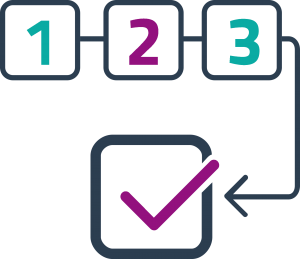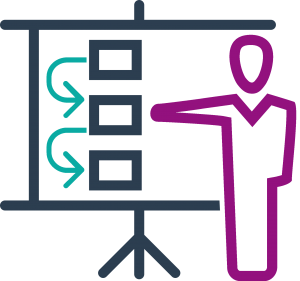

Defining the best strategy is a major corporate issue and deploying it efficiently and successfully in the whole organisation is the key to success. Our experience in correcting failing strategies has highlighted causes such as lack of clear focus and accepted action plans. If it is unsatisfactorily deployed, even the best strategy remains inefficient!
A clear vision of the entities’ strategic alignments is required to drive common and steady progress.
The 5 steps framework makes possible to establish clear actor specific action plans and to consolidate progress in simple strategic dashboards. Those dashboards can be analysed easily according to company expertise or organic / geographic repartition.
Case study : General deployment of an IT network in an industrial group

In an evolutive market, it is important to be able to adopt new processes to maintain competitiveness. The necessity to involve numerous teams in distant sites and in a controlled deadline makes the process complex. Their impact on the organisation must therefore be mastered.
A clear vision of the teams’ and entities’ assimilation and continuous processes improvement is required to drive common progress.
In an organization, the deployment of new processes must be fast, well-described, under control, lively, and adopted progressively and consistently by all entities.
Case study : Increase in the welcoming process in a public service

Because of the technical nature of today’s solutions, their development and increasing efficiency often mean that the solutions need to embrace all facets of an organization. For example, the organizational impacts, the training of individuals, the preparation of partnerships or the alignment of some corporate systems of reference can be critical to the success or failure of the implementation of a solution which can only be seen, fundamentally, as a technical problem. Implementing and really assimilating these solutions leads to significant and rapid change in management in complex organizations which are often multi-site and multi-cultural.
It is necessary to have a clear vision of the progression of teams and entities in order to drive the increase of common competences and ensure a real acceptance of the change.
The 5 steps framework makes possible to ensure that every aspect of an issue, the “Action Levers”, are properly considered by all sites. This framework helps identify when sites are not ready or do not have the ressources for a specific ‘action lever’.
Case study : TCO practice implementation

In a competitive and evolving market, it is necessary for an organization to regularly challenge and drive change in order to maintain its competitivity.
Driving change usually induces reorganization and shifts in behaviour.
A clear vision of team and entity progression is required to drive change.
The roadmap for change is set out and structured in 5 successive stages. This roadmap is based on the facts. Achieving these reaches intermediate objectives. Thus the path to change gains rhythm and is documented; anyone can appropriate their objectives. Distribution of the roadmap and its self-evaluation by every team member provides a permanent measure of the progress of the change and the possible obstacles.
Case study : Groupwork on the reorganization of a level A Business school
Article on our blog: Driving the change
Training (Fr) : ‘Formation à la conduite du changement’

New methods have proved their effectiveness with regard to the competitiveness of organizations. But these methods are often complex because they imply significant organizational changes. It therefore becomes difficult to guarantee that there is a real assimilation over the long term.
A clear vision of the integration of standards by teams and entities is required to ensure common acceptance and maximum effectiveness.
The integration of internal or international standards into 5 steps roadmaps makes effective the increase of implementation & monitoring.
With the 5 steps framework, a real integrated management system can be organized rapidly, integrating the existing benchmarks (EFQM, CMMI, Cobit, ITIL, BSC), norms (ISO 14000, SD 2100) or regulations (REACH, LOLF, Sarbanes-Oxley).
Case study : REACH conformity process in an industrial firm
Article on our blog : Manage the externalisaiton of your IT (with a 5 steps™ ITIL roadmap)
La société 5 steps, composée de consultants et d'une équipe R&D, développe la méthode, anime un réseau de partenaires experts, assure la formation et l'accompagnement de ses clients sur des missions de mise en oeuvre.